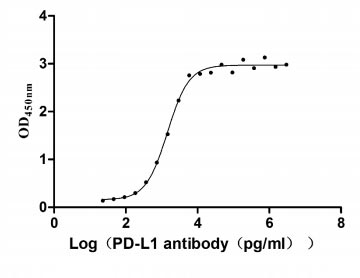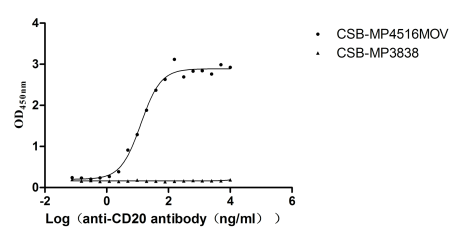Recombinant Mouse E3 SUMO-protein ligase RanBP2 (Ranbp2), partial
-
中文名稱(chēng):小鼠Ranbp2重組蛋白
-
貨號(hào):CSB-YP861698MO
-
規(guī)格:
-
來(lái)源:Yeast
-
其他:
-
中文名稱(chēng):小鼠Ranbp2重組蛋白
-
貨號(hào):CSB-EP861698MO
-
規(guī)格:
-
來(lái)源:E.coli
-
其他:
-
中文名稱(chēng):小鼠Ranbp2重組蛋白
-
貨號(hào):CSB-EP861698MO-B
-
規(guī)格:
-
來(lái)源:E.coli
-
共軛:Avi-tag Biotinylated
E. coli biotin ligase (BirA) is highly specific in covalently attaching biotin to the 15 amino acid AviTag peptide. This recombinant protein was biotinylated in vivo by AviTag-BirA technology, which method is BriA catalyzes amide linkage between the biotin and the specific lysine of the AviTag.
-
其他:
-
中文名稱(chēng):小鼠Ranbp2重組蛋白
-
貨號(hào):CSB-BP861698MO
-
規(guī)格:
-
來(lái)源:Baculovirus
-
其他:
-
中文名稱(chēng):小鼠Ranbp2重組蛋白
-
貨號(hào):CSB-MP861698MO
-
規(guī)格:
-
來(lái)源:Mammalian cell
-
其他:
產(chǎn)品詳情
-
純度:>85% (SDS-PAGE)
-
基因名:Ranbp2
-
Uniprot No.:
-
別名:Ranbp2; E3 SUMO-protein ligase RanBP2; EC 2.3.2.-; Ran-binding protein 2; RanBP2
-
種屬:Mus musculus (Mouse)
-
蛋白長(zhǎng)度:Partial
-
蛋白標(biāo)簽:Tag?type?will?be?determined?during?the?manufacturing?process.
The tag type will be determined during production process. If you have specified tag type, please tell us and we will develop the specified tag preferentially. -
產(chǎn)品提供形式:Lyophilized powder
Note: We will preferentially ship the format that we have in stock, however, if you have any special requirement for the format, please remark your requirement when placing the order, we will prepare according to your demand. -
復(fù)溶:We recommend that this vial be briefly centrifuged prior to opening to bring the contents to the bottom. Please reconstitute protein in deionized sterile water to a concentration of 0.1-1.0 mg/mL.We recommend to add 5-50% of glycerol (final concentration) and aliquot for long-term storage at -20℃/-80℃. Our default final concentration of glycerol is 50%. Customers could use it as reference.
-
儲(chǔ)存條件:Store at -20°C/-80°C upon receipt, aliquoting is necessary for mutiple use. Avoid repeated freeze-thaw cycles.
-
保質(zhì)期:The shelf life is related to many factors, storage state, buffer ingredients, storage temperature and the stability of the protein itself.
Generally, the shelf life of liquid form is 6 months at -20°C/-80°C. The shelf life of lyophilized form is 12 months at -20°C/-80°C. -
貨期:Delivery time may differ from different purchasing way or location, please kindly consult your local distributors for specific delivery time.Note: All of our proteins are default shipped with normal blue ice packs, if you request to ship with dry ice, please communicate with us in advance and extra fees will be charged.
-
注意事項(xiàng):Repeated freezing and thawing is not recommended. Store working aliquots at 4°C for up to one week.
-
Datasheet :Please contact us to get it.
靶點(diǎn)詳情
-
功能:E3 SUMO-protein ligase which facilitates SUMO1 and SUMO2 conjugation by UBE2I. Involved in transport factor (Ran-GTP, karyopherin)-mediated protein import via the F-G repeat-containing domain which acts as a docking site for substrates. Binds single-stranded RNA (in vitro). May bind DNA. Component of the nuclear export pathway. Specific docking site for the nuclear export factor exportin-1. Sumoylates PML at 'Lys-490' which is essential for the proper assembly of PML-NB. Recruits BICD2 to the nuclear envelope and cytoplasmic stacks of nuclear pore complex known as annulate lamellae during G2 phase of cell cycle. Probable inactive PPIase with no peptidyl-prolyl cis-trans isomerase activity.
-
基因功能參考文獻(xiàn):
- These results demonstrate a function of RanBP2-mediated SUMOylation of SHP in maintaining bile acids (BA) homoeostasis and protecting from the BA hepatotoxicity. PMID: 27412403
- results demonstrate that Ranbp2 controls nucleocytoplasmic, chemokine and metalloproteinase 28 signaling, and proteostasis of substrates that are crucial to motoneuronal homeostasis and whose impairments by loss of Ranbp2 drive ALS-like syndromes PMID: 28100513
- RanBP2 expression was regulated by Zap70. PMID: 28745977
- Data (including data from studies in transgenic/knockout mice) suggest that Ranbp2 in photoreceptor neurons participates in coupling of photoreceptor degeneration (neural dysmorphology) and apoptosis (neural death) caused by toxic exposure to light. PMID: 26632511
- These studies unravel selective roles of Ranbp2 and its RBD2 and RBD3 in retinal pigment epithelium survival and functions. PMID: 25187515
- These results unveil distinct mechanistic and biological links between prolyl isomerase and chaperone activities of Ranbp2 cyclophilin toward proteostasis. PMID: 24403063
- Novel roles in Ran GTPase-independent subdomains of RBD2 and RBD3, and KBD of RanBP2, confer antagonizing and multi-modal mechanisms of kinesin-1 activation and regulation of mitochondrial motility. PMID: 23536549
- Ranbp2 haploinsufficiency is associated with metabolic imbalances leading to parkinson's disease. PMID: 22821000
- Knockdown of RANBP2 specifically affected the late step of nuclear entry, inducing cytoplasmic granules enriched with phosphorylated components. This suggests a novel regulatory mechanism for nuclear speckle formation involving RANBP2 and phosphorylation. PMID: 22262462
- findings indicate that the nuclear pore complex undergoes dynamic remodeling during muscle cell differentiation and that Nup358 is prominently involved in the remodeling process PMID: 21205196
- These results provide a rationale for the neuroprotection from light damage of photosensory neurons by RANBP2 insufficiency. PMID: 20682751
- RanBP2 associates in vitro and in vivo and colocalizes with the mitochondrial metallochaperone, Cox11, and the pacemaker of glycolysis, hexokinase type I (HKI) via its leucine-rich domain. PMID: 17069463
- these data identify RanBP2 as a chromosomal instability gene that regulates Topo IIalpha by sumoylation and suppresses tumorigenesis. PMID: 18394993
- The RAN binding protein 2-dependent production of free fatty acids or metabolites promote apoptosis of photoreceptors in concert with the light-stimulated production of reactive oxygen species. PMID: 18949001
- reports identification of the cyclophilin-related protein, RanBP2 (note at the time the protein was not designated RanBP2), and the cis-trans prolyl isomerase activity of its cyclophilin domain PMID: 7559465
- reports interaction of the RBD4 and CY domains of RanBP2 with red/green opsin and the chaperone activity of these domains toward red/green opsin. PMID: 8857542
- reports identification of a binding domain in RanBP2, the cyclophilin-like domain, toward components of the 19S cap of the proteasome PMID: 9733766
- reports identification of a binding domain in RanBP2, the zinc-finger rich domain, toward CRM1/exportin-1 PMID: 10601307
- reports identification of a novel domain in RanBP2 located between RBD2 and RBD3 with specific binding activity against the conventional heavy chain kinesins, KIF5B and KIF5C PMID: 11553612
- reports the novel subcellular localizations of RanBP2 in retinal neurons of human and bovine PMID: 12191015
顯示更多
收起更多
-
亞細(xì)胞定位:Nucleus. Nucleus membrane. Nucleus, nuclear pore complex. Nucleus envelope.
-
蛋白家族:RanBP2 E3 ligase family
-
數(shù)據(jù)庫(kù)鏈接:
Most popular with customers
-
Recombinant Human Programmed cell death 1 ligand 1 (CD274), partial (Active)
Express system: Mammalian cell
Species: Homo sapiens (Human)
-
Recombinant Human HLA class II histocompatibility antigen gamma chain (CD74), partial (Active)
Express system: Mammalian cell
Species: Homo sapiens (Human)
-
Recombinant Macaca fascicularis Membrane spanning 4-domains A1 (MS4A1)-VLPs (Active)
Express system: Mammalian cell
Species: Macaca fascicularis (Crab-eating macaque) (Cynomolgus monkey)
-
Recombinant Human Killer cell immunoglobulin-like receptor 3DL2 (KIR3DL2), partial (Active)
Express system: Mammalian cell
Species: Homo sapiens (Human)
-
Recombinant Human C-C chemokine receptor type 5 (CCR5)-VLPs (Active)
Express system: Mammalian cell
Species: Homo sapiens (Human)



-AC1.jpg)












